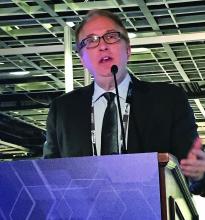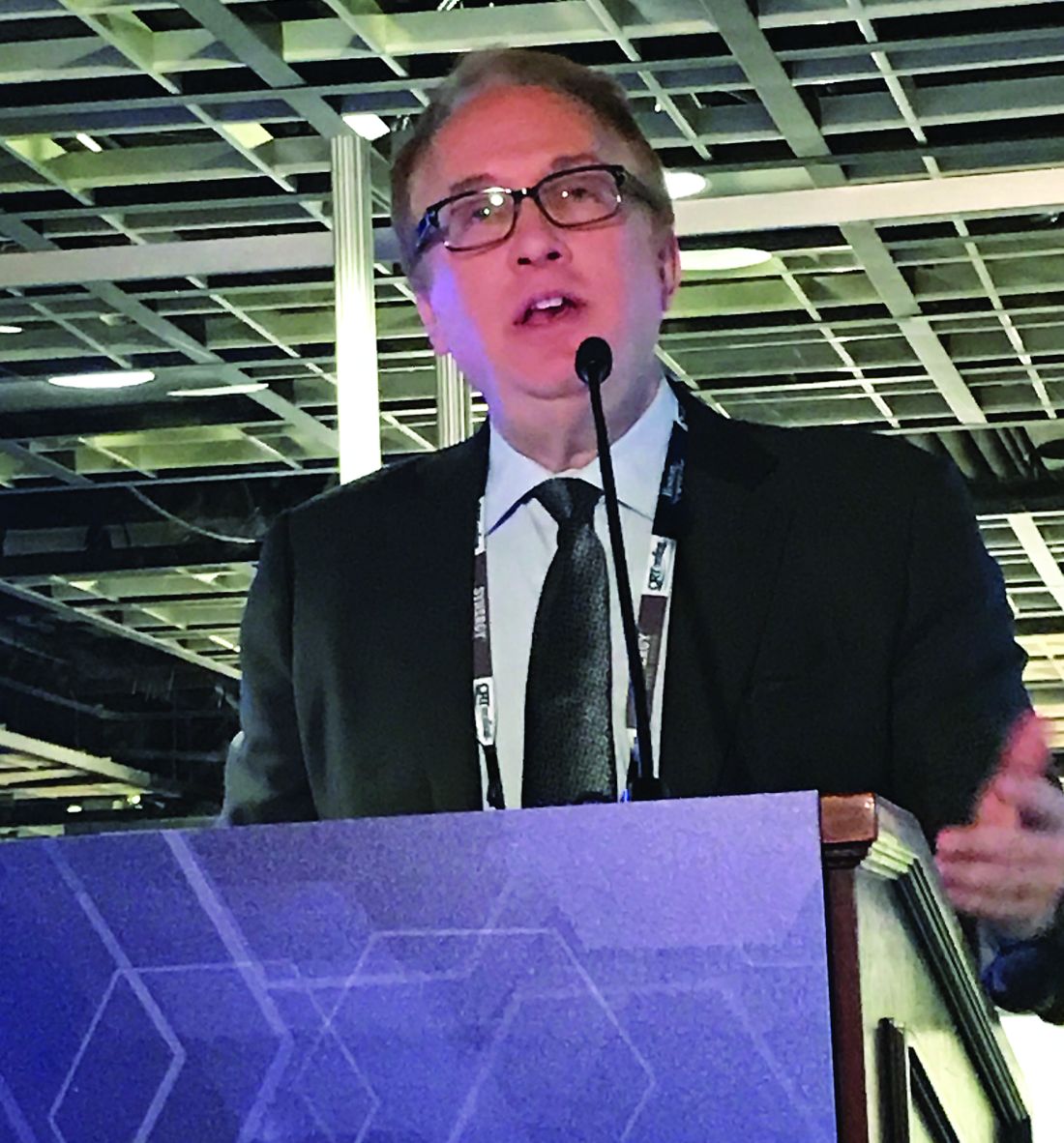User login
WASHINGTON – The published results with bioresorbable stents have been disappointing, but most interventionalists think such devices have the potential to prevail over drug-eluting stents by addressing unmet needs, judging from a debate on this topic that took place at CRT 2018 sponsored by the Cardiovascular Research Institute at Washington Hospital Center..
“There is a clinical need for bioresorbable stents [BRS] unless drug-eluting stents [DES] are perfect, and I think we agree that they are not perfect,” argued Gregg Stone, MD, director of cardiovascular research and education at Columbia University Medical Center, New York.
“It does not matter what device you evaluate,” Dr. Stone said. Whether caused by late polymer sensitivity reactions, late strut fractures, or neoatherosclerosis formation, failure can occur suddenly after a decade or more in DES that were performing well up until that point, according to data cited by Dr. Stone. This is one of the key risks that BRS technology was designed to address.
“We now know that the bioresorbable scaffold is replaced by normal tissue at 3 years,” Dr. Stone said. He reported that he is encouraged by the absence of any scaffold thrombosis after 3 years in a recent series of 501 patients with a BRS that have been followed at least 4 years. “This is the first time that we have seen that,” he asserted, adding, “The concept is there.”
His debate opponent, Stephan Windecker, MD, director of invasive cardiology at the Swiss Cardiovascular Center in Bern, cited numerous studies to conclude that “there is clear inferiority” of BRS relative to DES for most important clinical outcomes, including TLF. Although he acknowledged late TLF does occur with DES devices, he contended that new design changes are at least as likely to mitigate risk in DES as improvements in BRS.
However, Dr. Stone suggested that reductions in strut thickness might be the answer for reduced TLF for both BRS and DES devices. If so, there are several reasons to believe that this would ultimately favor BRS as the dominant technology.
“We did not get there with the 150-mcm strut thickness scaffold, but now we have struts as thin as 80 mcm. I’m pretty confident that with smaller struts we will see great results,” countered Dr. Stone.
Returning to the theme that BRS devices address an unmet need, Dr. Stone contended that BRS is the preferred strategy if advances render BRS and drug-eluting stents equally safe and effective. Not least of the reasons is patient preference. “It is an undeniable fact that based on cultural, religious, or personal beliefs, many patients prefer not to live their lives with a permanently implanted device,” he said.
The audience agreed. Asked for a show of hands regarding whether bioresorbable stents technology has the potential to address an unmet need, the majority vote was overwhelmingly in favor of Dr. Stone’s position. Based on a visual vote count that seemed to clearly affirm that BRS addresses and unmet need, Dr. Stone contended that a statistical analysis would have had a P value “with about eight zeros after the decimal point.”
Dr. Stone reports a financial relationship with Reva Medical. Dr. Windecker reports financial relationships with Abbott, Boston Scientific, Biotronik, Edwards Lifesciences, Medtronic, and St. Jude.
WASHINGTON – The published results with bioresorbable stents have been disappointing, but most interventionalists think such devices have the potential to prevail over drug-eluting stents by addressing unmet needs, judging from a debate on this topic that took place at CRT 2018 sponsored by the Cardiovascular Research Institute at Washington Hospital Center..
“There is a clinical need for bioresorbable stents [BRS] unless drug-eluting stents [DES] are perfect, and I think we agree that they are not perfect,” argued Gregg Stone, MD, director of cardiovascular research and education at Columbia University Medical Center, New York.
“It does not matter what device you evaluate,” Dr. Stone said. Whether caused by late polymer sensitivity reactions, late strut fractures, or neoatherosclerosis formation, failure can occur suddenly after a decade or more in DES that were performing well up until that point, according to data cited by Dr. Stone. This is one of the key risks that BRS technology was designed to address.
“We now know that the bioresorbable scaffold is replaced by normal tissue at 3 years,” Dr. Stone said. He reported that he is encouraged by the absence of any scaffold thrombosis after 3 years in a recent series of 501 patients with a BRS that have been followed at least 4 years. “This is the first time that we have seen that,” he asserted, adding, “The concept is there.”
His debate opponent, Stephan Windecker, MD, director of invasive cardiology at the Swiss Cardiovascular Center in Bern, cited numerous studies to conclude that “there is clear inferiority” of BRS relative to DES for most important clinical outcomes, including TLF. Although he acknowledged late TLF does occur with DES devices, he contended that new design changes are at least as likely to mitigate risk in DES as improvements in BRS.
However, Dr. Stone suggested that reductions in strut thickness might be the answer for reduced TLF for both BRS and DES devices. If so, there are several reasons to believe that this would ultimately favor BRS as the dominant technology.
“We did not get there with the 150-mcm strut thickness scaffold, but now we have struts as thin as 80 mcm. I’m pretty confident that with smaller struts we will see great results,” countered Dr. Stone.
Returning to the theme that BRS devices address an unmet need, Dr. Stone contended that BRS is the preferred strategy if advances render BRS and drug-eluting stents equally safe and effective. Not least of the reasons is patient preference. “It is an undeniable fact that based on cultural, religious, or personal beliefs, many patients prefer not to live their lives with a permanently implanted device,” he said.
The audience agreed. Asked for a show of hands regarding whether bioresorbable stents technology has the potential to address an unmet need, the majority vote was overwhelmingly in favor of Dr. Stone’s position. Based on a visual vote count that seemed to clearly affirm that BRS addresses and unmet need, Dr. Stone contended that a statistical analysis would have had a P value “with about eight zeros after the decimal point.”
Dr. Stone reports a financial relationship with Reva Medical. Dr. Windecker reports financial relationships with Abbott, Boston Scientific, Biotronik, Edwards Lifesciences, Medtronic, and St. Jude.
WASHINGTON – The published results with bioresorbable stents have been disappointing, but most interventionalists think such devices have the potential to prevail over drug-eluting stents by addressing unmet needs, judging from a debate on this topic that took place at CRT 2018 sponsored by the Cardiovascular Research Institute at Washington Hospital Center..
“There is a clinical need for bioresorbable stents [BRS] unless drug-eluting stents [DES] are perfect, and I think we agree that they are not perfect,” argued Gregg Stone, MD, director of cardiovascular research and education at Columbia University Medical Center, New York.
“It does not matter what device you evaluate,” Dr. Stone said. Whether caused by late polymer sensitivity reactions, late strut fractures, or neoatherosclerosis formation, failure can occur suddenly after a decade or more in DES that were performing well up until that point, according to data cited by Dr. Stone. This is one of the key risks that BRS technology was designed to address.
“We now know that the bioresorbable scaffold is replaced by normal tissue at 3 years,” Dr. Stone said. He reported that he is encouraged by the absence of any scaffold thrombosis after 3 years in a recent series of 501 patients with a BRS that have been followed at least 4 years. “This is the first time that we have seen that,” he asserted, adding, “The concept is there.”
His debate opponent, Stephan Windecker, MD, director of invasive cardiology at the Swiss Cardiovascular Center in Bern, cited numerous studies to conclude that “there is clear inferiority” of BRS relative to DES for most important clinical outcomes, including TLF. Although he acknowledged late TLF does occur with DES devices, he contended that new design changes are at least as likely to mitigate risk in DES as improvements in BRS.
However, Dr. Stone suggested that reductions in strut thickness might be the answer for reduced TLF for both BRS and DES devices. If so, there are several reasons to believe that this would ultimately favor BRS as the dominant technology.
“We did not get there with the 150-mcm strut thickness scaffold, but now we have struts as thin as 80 mcm. I’m pretty confident that with smaller struts we will see great results,” countered Dr. Stone.
Returning to the theme that BRS devices address an unmet need, Dr. Stone contended that BRS is the preferred strategy if advances render BRS and drug-eluting stents equally safe and effective. Not least of the reasons is patient preference. “It is an undeniable fact that based on cultural, religious, or personal beliefs, many patients prefer not to live their lives with a permanently implanted device,” he said.
The audience agreed. Asked for a show of hands regarding whether bioresorbable stents technology has the potential to address an unmet need, the majority vote was overwhelmingly in favor of Dr. Stone’s position. Based on a visual vote count that seemed to clearly affirm that BRS addresses and unmet need, Dr. Stone contended that a statistical analysis would have had a P value “with about eight zeros after the decimal point.”
Dr. Stone reports a financial relationship with Reva Medical. Dr. Windecker reports financial relationships with Abbott, Boston Scientific, Biotronik, Edwards Lifesciences, Medtronic, and St. Jude.
EXPERT ANALYSIS FROM CRT 2018


